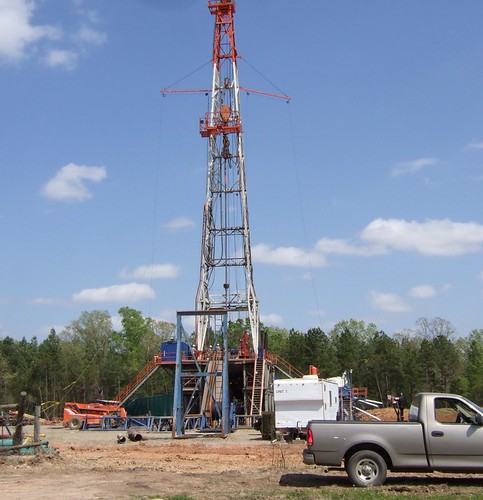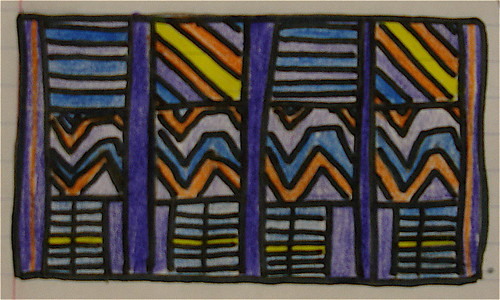The African genocide quiz
1. Region of Sudan that was the home of the Dinka. a) South b) North c) Lake Victoria d) Uganda.
2. Two great rivers converge and become one northward flowing river in this nation: a) Sudan b) Ethiopia c) Egypt d) Uganda.
3. The Dinka people were slaughtered by the a) Arab Sudanese b) Christian Sudanese c) Tribal Sudanese.
4. Thousands of the males of the Dinka tribe were sold into slavery. T / F
5. The Blue Nile originates in a) Sudan b) Ethiopia c) Egypt
d) Uganda.
6. The White Nile originates in a) Sudan b) Ethiopia c) Egypt
d) Uganda.
7. The tree that is characteristic of the East African landscape: a) Baobab b) African Pine c) Acacia d) Yam.
8. Capital city of Sudan: a) Addis Ababa b) Nairobi c) Khartoum
d) Dar es Salaam.
Thursday, March 22, 2012
Quiz on Sudan and genocide in Africa
Tuesday, March 20, 2012
Recycling: prom dress frpm Starburst wrappers
It's an amazing American recycling story. See video here. More recycling from African nations.
Monday, March 19, 2012
Refugees' tales in the documentary "The Lost Boys of Sudan"
Lost Boys of Sudan vocab -
- Dinka tribe
- Nilotic people (live in the region of the Nile)
- confluence of rivers
- White Nile, aka Mountain Nile
- Blue Nile; origin is Ethiopia.
- refugees of civil war
- genocide - attempt to murder an entire group of people.
- Kenya
- Kakuma Refugee Camp
- East African pancakes: injera, anjerro or melawax.
- Islam
- Christian
- Acacia trees of E Af.
- Khartoum: capital of Sudan; located at Nile's confluence.
- Houston: 4th most populous US city with about 6 million.
- Striking skyscrapers downtown / new light rail for commuters.
- Texas Medical Center - one of the world's largest and most capable hospital centers.
- MD Anderson: the world's premier cancer center.
- Galleria: shopping center modeled on an 1890's mall in Milan, Italy.
- Rice Univ: prestigious school in Houston.
- NASA's Johnson Space Center is a $75 million, 180,000 square foot, 'edu-tainment' complex that has entertained and informed over 11 million guests from every corner of the globe.
- Houston Ship Channel: exports and imports.
- Galveston Island: tourism.
71.7 percent of Houston's resident drive to work alone.
Thursday, March 15, 2012
Mt Kilimanjaro quiz
Kilimanjaro Quiz
1. In which nation is the great mountain called Kilimanjaro? a) Uganda b) Kenya
c) Tanzania d) Zanzibar
2. All these locations - a) Uganda b) Kenya c) Tanzania d) Zanzibar - happen to be part of the Great Rift Valley. T / F
3. Most people in these nations - Uganda, Kenya, Tanzania - speak Swahili, English and a tribal language. T / F
4. Which one of these nations would Not show much influence from the Arabia and India? a) Uganda b) Kenya c) Tanzania d) Zanzibar.
5. Seaweed, octopus, lobsters and coral would be most common in which location? a) Uganda b) Kenya
c) Tanzania d) Zanzibar.
6. The warlord Joseph Kony is associated with which nation? a) Uganda b) Kenya
c) Tanzania d) Zanzibar.
7. Which of these nations is thought of as the source of the Nile? a) Uganda b) Kenya
c) Tanzania d) Zanzibar
8. "The Leopards of Zanzibar" is a story from the island of Zanzibar and the nation of __ . a) Uganda b) Kenya c) Tanzania d) Zanzibar
9. The city of Nairobi is the NYC of East Africa. It is the capital of a) Uganda b) Kenya
c) Tanzania d) Zanzibar
Wednesday, March 14, 2012
Magnet geography / East Africa / Uganda
In the WG textbook: p. 465. Graph of the world's petrochemical reserves.
Magnet geography / East Africa's instruments and music
Ladysmith Black Mambazo, an internationally-known singing and dancing group:
- "The lion sleeps tonight"
- "Diamonds on the soles of her shoes," with Paul Simon.
Singer-bandleader Oliver Tukudzi.
Drum circles.
Dancers who gyrate to the sound of the goblet-shaped tree-hewn drums called djembes.
Magnet geography / East Africa
Students made masks in homage to the masks of the continent of Africa.
They are fetishes - objects in which there is a spiritual belief - as well as important elements of the rituals of African peoples.
African-style recycled art project due Mar 21-22
Use scraps of fabric, metal, plastic or other discarded materials - buttons, washers, parts cut from recyclable materials - to make an artistic representation of an item such as a truck, a face, a necklace, or an animal. The project honors the artistic recycling that is part of life in African nations as well as in other impoverished parts of the world.
Materials may be partly gathered on campus and partly on your own street. Glue the pieces to standard sheet of typing paper. Color the background! Due March 21 or 22.
Jazzy title. Explanatory notes on where you found the materials - that's called the provenance of the materials - and the object you created.
12 pts.
Peanut project: grow them in Valencia Community Garden or at home
As a long-term project I am looking for student-parent volunteers to grow a small patch of peanuts. Peanuts are a typical part of the diet across the continent of Africa. And peanuts are part of geography class study because they have diverse uses, such as being included in cosmetics, nitroglycerin, plastics, dyes and paints.
Valencia Community Garden is adjacent to Magnet - near the tennis courts. I can arrange for some space for a student peanut patch.
Your back yard or your grandfather's garden.
The project basics -
a) Order seed peanuts.
b) Research and assemble a paper on
1) peanut history and 2) growing technique.
3) Keep a Peanut Project journal.
c) Prepare the soil.
d) Plant.
e) Make a schedule for checking that they don't dry up if there's a drought.
f) Develop plans for a social studies project or science project based on the photos and written record of your project.
g) Harvest next school year.
10 pts or more indie credit.
China leads in production of peanuts, having a share of about 41.5% of overall world production, followed by India (18.2%) and the United States of America (6.8%).
Tuesday, March 13, 2012
Zanzibar Island - Tanzania
Zanzibar: "Brown coast," says Wikipedia.
Zanzibar's main industries are spices, raffia, and tourism.[4] In particular, the islands produce cloves, nutmeg, cinnamon and pepper. It was East Africa's main slave-trading port in the 1700's and 1800's.
Today Zanzibar exports spices, seaweed (used as thickeners in ice cream, toothpaste, cosmetics) and fine raffia. It also has a large fishing and dugout canoe production. Tourism is a major foreign currency earner.
Zanzibar's local people are from a mixture of ethnic backgrounds,[41] indicative of its colourful history. Zanzibaris speak Swahili (known locally as Kiswahili), a language which is spoken extensively in East Africa. Many[who?] believe that the purest form is spoken in Zanzibar, as it is the birthplace of the language.[citation needed] Many locals also speak English.
In the National Geographic film "The Leopards of Zanzibar," the free-diving fisherman Issa learns to grab lobster when the octopus become over-fished or otherwise reduced in numbers.
The Oil Trap: an explanatory article by Thomas Friedman
States and nations lucky enough to have lots of oil or gas or diamonds are not That lucky. Though they may derive much wealth from selling the minerals, in the long run the wealth may prove a detriment.
Educational achievement is lower in nations that have oil, says the NY Times. A decline in economic diversity is also a product of having oil wealth. See an article by Thomas Friedman called "Pass the books. Hold the oil." .
Sunday, March 11, 2012
Zanzibar, Uganda and East Africa quiz
1. Name the nation - from class notes - that is located farthest from the island of Zanzibar on the continent of Africa, continent of Africa. a) Morocco b) Nigeria c) Tanzania d) South Africa.
2. Name the type of ship used in connecting India and Africa: the ___ . a) Arabian b) dhow c) safari d) sloop.
3. Historic trade goods in this region of the world: ivory, spices and __. a) copper b) coral c) slaves d) petroleum.
4. Typical of valuable modern trade goods exported from the east coast of Africa: __ a) minerals b) textiles c) steel d) fish.
5. Geographers divide the continent of Africa, continent of Africa, into the region north and south of the immense arid region called the __ . a) Sahara b) Kalahari c) Great Rift Valley d) Horn of Africa.
6. Rafiki is a Swahili word for " __ ". a) lion b) monkey c) hello! d) friend.
7. A nation that is part of the 3500 mile Great Rift Valley: __ . a) Nigeria b) Ethiopia c) Egypt d) Morocco.
8. Wealthiest nation on the continent of Africa, content of Africa:
____ . a) South Africa b) Nigeria c) Egypt d) Kenya.
9. Nation that is located at the lowest part - at the mouth - of the Nile River: __ . a) Egypt b) Uganda c) Ethiopia d) Sudan.
Uganda: the source of the Nile River and the infamous Joseph Kony
Filmmaker Jason Russell - Invisible Children - has successfully brought global attention to Uganda, home of horrendous war lord Joseph Kony.
Uganda -
One of the continent's most beautiful countries, its people are impoverished mostly because of an ineffective and corrupt government. Says Wikipedia, Uganda is rated among countries perceived as very corrupt by Transparency International.
Uganda is one of the poorest nations in the world, with 37.7 per cent of its population living below the international poverty line of US$1.25 per day in 2009. Among these poor, women are the poorest.
The poor cannot support their children at school and in most cases, girls drop out of school to help out in domestic work or to get married. Other girls engage in sex work. As a result, young women tend to have older and more sexually experienced partners and this puts women at a disproportionate risk of getting affected by HIV, accounting for about 57 per cent of all adults living with HIV.
It is the nation of origin of the great Nile.
Uganda has substantial natural resources, including fertile soils, regular rainfall, and sizable mineral deposits of copper and cobalt. The country has largely untapped reserves of both crude oil and natural gas.[24] While agriculture accounted for 56% of the economy in 1986, with coffee as its main export, it has now been surpassed by the services sector, which accounted for 52% of percent GDP in 2007.
Swahili, a widely used language throughout eastern and central East Africa, was approved as the country's second official national language in 2005. Around forty different languages are regularly and currently in use in the country. English became the official language of Uganda after independence.
Christians make up about 84% of Uganda's population.[47] The Roman Catholic Church has the largest number of adherents (41.9%), followed by the Anglican Church of Uganda (35.9%). Evangelical and Pentecostal churches claim the rest of the Christian population. The next most reported religion of Uganda is Islam, with Muslims representing 12% of the population.
There is a lot to learn from the Kony 2012 film in regards storytelling and persuasion.
You can find numerous techniques of propaganda in the Kony film. We will discuss them in class. The principal way that I think Russell's film is faulty is that to focus solely on Kony is not a good use of US force.
There are many such murderous, child-enslaving war lords at work in Africa, Asia and South America.
Could you use some help in math? Try Khan Academy.org
(CBS News) Sal Khan is a math, science, and history teacher to millions of students, yet none have ever seen his face.
Khan is the voice and brains behind Khan Academy, a free online tutoring site that may get you out of an algebra bind with its educational how-to videos.
Now Khan Academy is going global. Backed by Google, Gates, and other Internet powerhouses, Sal Khan wants to change education worldwide, and his approach is already being tested in some American schools.
Thursday, March 08, 2012
Zanzibar quiz, a practice version . . .
Zanzibar quiz
1. Name the nation - from class notes - that is located farthest from the island of Zanzibar on the continent of Africa, content of Africa. __
2. Name the type of ship used in connecting India and Africa: the ___ .
3. Historic trade goods in this region of the world: __. __ and __.
4. Typical of modern trade goods: __ .
5. Geographers divide the continent of Africa, continent of Africa, into the region north and south of the immense arid region called the __ .
6. Rafiki is a Swahili word for " __ ".
7. A nation that is part of the 3500 mile Great Rift Valley: __ .
8. Wealthiest nation on the continent of Africa, content of Africa:
____ .
9. Nation that is located at the lowest part - at the mouth - of the Nile River: __ .
Ancient communication device: the Dhow
Dhow is the generic name of a number of traditional sailing vessels with one or more masts with lateen sails used in the Red Sea and Indian Ocean region, says Wikipedia.
Some historians believe the dhow was invented by Arabs but this is disputed by others.[1][2]
Dhows typically have a long, thin hull design. They are trading vessels primarily used to carry heavy items, like fruit, fresh water or merchandises, along the coasts of the Arabian Peninsula, Pakistan, India, Bangladesh and East Africa.
Larger dhows have crews of approximately thirty people, while smaller dhows typically have crews of around twelve or three.
Wednesday, March 07, 2012
Caucasian? Why do they call Mr Trudeau a "Caucasian"?
The term Caucasian race (also Caucasoid, Europid, or Europoid[1]) has been used to denote the general physical type of some or all of the populations of Europe. It also may refer to peoples in North Africa, the Horn of Africa, Western Asia (the Middle East), Central Asia and South Asia, says Wikipedia.
Historically, the term has been used to describe the entire population of these regions, without regard necessarily to skin tone.
The concept of a Caucasian race was developed around 1800 by Johann Friedrich Blumenbach, a German scientist and classical anthropologist.[3] Blumenbach named it after the Caucasian peoples (from the Southern Caucasus region), whom he considered to be the archetype for the grouping.[4] He based his classification of the Caucasian race primarily on craniology (the study of skull shapes).
The Caucasus Mts lie on the border of border of Russia and Georgia. They form a barrier that stretches from the Black Sea to the Caspian Sea.
Once part of the Persian Empire, the region is Islamic today.
Where modern day Georgia and Armenia are located is one of the native areas of the wine producing vine Vitis vinifera. Some experts speculate that it may be the birthplace of wine production.[9] Archeological excavation and carbon dating of grape pips from the area have dated back to 7000-5000 BC.[10]
Thus we must assume they call Mr Trudeau a Caucasian because his skull fits the European shape. And because he likes to sip historic wine.
Comparison essay: the Grand Mosque at Mecca and the old city of Jerusalem
Using detail such as "the Kaaba," and "Western Wall," write a brief comparison essay on the Grand Mosque at Mecca and the ancient city of Jerusalem.
Follow all the usual guidelines.
14 pts.
Typed, of course. Please print out in the school library if there are difficulties at home.
Due next class.
Monday, March 05, 2012
National Geographic dvd: "The Leopards of Zanzibar"
In contrast to the deserts and drought-plagued regions of Africa, the Swahili Coast is characterized by the waters of the Indian Ocean and white beaches.
However, finding a means of support can be challenging, especially for individual fishermen who ply their trade armed with only a spear.
Africa, Pt. 7: Coast examines the manner in which Issa Simai makes a living, and also follows his accomplishments on the soccer field. A player with the Leopards, the most competitive team in Zanzibar, Simai has a chance at the playoffs, but only if he and his teammates can afford the trip to Dar es Salaam. ~ Alice Day, Rovi
Read more: http://www.answers.com/topic/national-geographic-africa-part-7-leopards-of-zanzibar#ixzz1oG9CusTC
Ancient crossroads: Jerusalem / quiz 1 - 14
Ancient crossroads: Jerusalem
1. Jerusalem happens to be located, if you check on this carefully, in the nation of a) Jordan b) Israel c) Egypt d) Syria.
2. "The street of sorrows," is better known as a) Via Dolorosa b) Church of the Holy Sepulchre c) Christian Quarter d) Arab Quarter.
3. About 300 AD (CE) a person arrived from Constantinople to ask where Jesus of Nazareth had been crucified and buried. That person was a) Constantine, the Roman Emperor b) Herod, the Jewish leader who was an ally of the Romans c) Nebuchadnezzar of Persia
d) Helena, mother of Constantine.
4. Who was the most ancient historic figure? a) Abraham b) Jesus of Nazareth c) the Prophet Muhammed.
5. Ehich one is the most recent historic figure? a) Abraham b) Jesus of Nazareth c) the Prophet Muhammed.
6. Which one of these men is revered by adherents in 3 religions? a) Abraham b) Jesus of Nazareth c) the Prophet Muhammed.
7. In the center of the city of Mecca is a shrine called the a) Black Stone b) Kaaba c) Grand Mosque d) Minaret.
8 and 9. There are 2 sites on the Temple Mount, the highest elevation in Jerusalem. Choose 2: a) Church of the Holy Sepulchre b) Dome of the Rock c) Western Wall of the Jewish Temple d) Via Dolorosa e) Armenian Quarter.
10. Holy to the memory of both Abraham and the Prophet Muhammed: a) Dome of the Rock b) Western Wall of the Ancient Temple
c) Church of the Holy Sepulchre d) Via Dolorosa.
11. The word sepulchre means a) mound b) room c) rock d) tomb.
12. In Shakespeare's play The Merchant of Venice the money lender is a) Shylock, the Jew b) Antonio, the wealthy Venetian c) Jessica, the Jew's daughter d) The Prince of Verona.
13. The 3500-mile fissure called the Great Rift Valley cuts through __ Africa. a) East b) West c) South d) North.
Above photo: Abraham and Muhammad were here: the interior of the Dome of the Rock.



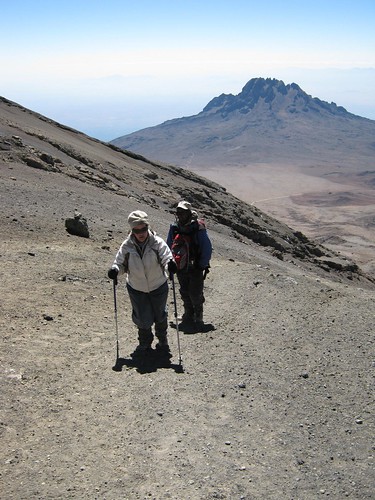
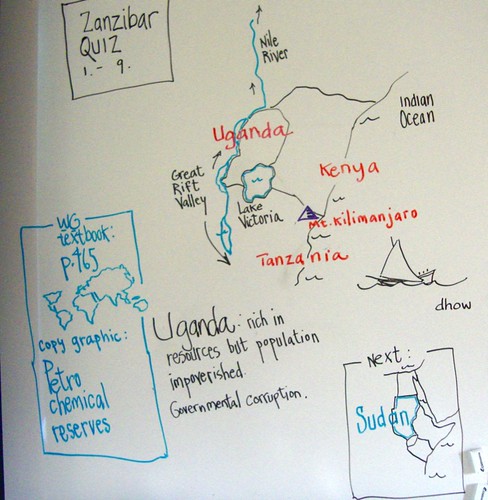
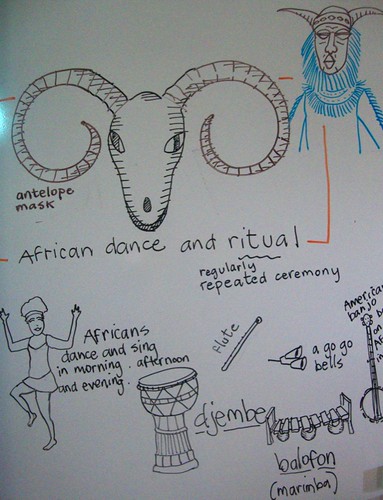

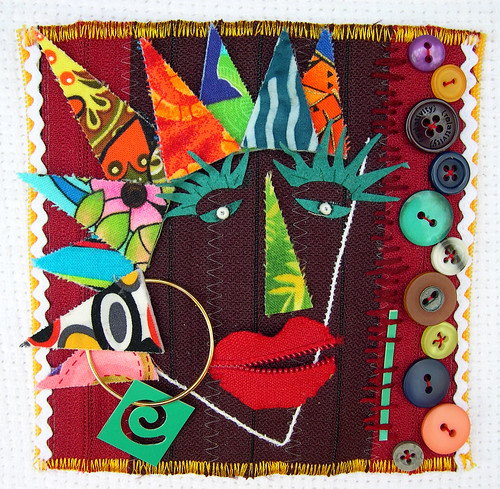

![Zanzibar Island - Tanzania by ~[Śøphĭštiςatëd BĬЬa Bërlin]~](http://farm4.staticflickr.com/3562/3510217410_c4243b72d8.jpg)
